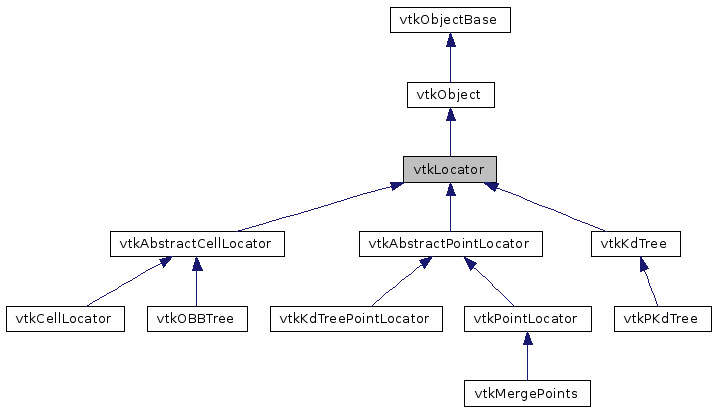VTK/Locator Refactoring
Background
Locators are spatial search objects. The principle behind locators is that they divide 3-space into small pieces (or "buckets") that can be quickly found in response to queries like point location, line intersection, or object-object intersection.
The current class hiearchy for locators is as follows.
vtkAbstractCellLocator and vtkAbstractPointLocator provide the API for cell and point locators. vtkCellLocator and vtkPointLocator are concrete subclasses that use uniform binning. vtkMergePoints is a specialized subclass that assumes a tolerance of 0 and optimizes accordingly. vtkKdTreePointLocator uses a K-D tree instead of uniform binning.
Issues with the current implementation
vtkPointLocator and vtkCellLocator work well when the cells/points are uniformly distributed. In such cases, they end up with roughly the same number of cells/points in each bucket and the linear search that happens in each bucket is fast. However, when the cells/points are not uniformly distributed, for example in the case of finite-element simulation of a boundary layer (e.g. flow around a wing), certain buckets end up with much larger number of cells/points and the performance becomes very poor. To address this issue, we have been developing locators that use adaptive binning - K-D trees or octrees. In order to be able to use these locators in existing VTK filters, we need to make some changes to the class hierarchy.
Proposed class hierarchy
Here is what we propose.

Things to note:
We added an abstract superclass called vtkIncrementalPointLocator. Currently, filters like the contour filter allow the user to set a locator which is a vtkPointLocator or subclass. However, vtkPointLocator already implements uniform binning and subclassing it to implement an octree-based binning, for example, would be poor design. We considered using vtkAbstractPointLocator instead. This has one major flaw: not all point locators can easily implement all of the API that is in vtkPointLocator. This is because vtkPointLocator has two modes:
- Build the search structure given the whole mesh
- Build the search structure incrementally as user adds more points
The second mode cannot be efficiently implemented in some locators. Therefore, we introduced a new superclass called vtkIncrementalPointLocator. This has all of vtkPointLocator's API but is abstract and allows us to subclass from it. We will change all vtkPointLocators to vtkIncrementalPointLocators.
We added two octree-based locators. There are vtkIncrementalOctreePointLocator and vtkOctreePointLocator. vtkOctreePointLocator is more efficient and should be used whenever possible.
We added vtkBSPTreeCellLocator. This is John Biddiscombe's cell locator that uses a BSP tree. Hopefully, he will contribute it.
We added vtkNonMergePointLocator. This is for when the user wants to skip merging of points all together, mainly for efficiency reasons.
We removed vtkKdTree from the hierarchy. vtkKdTree is not used as a locator and does not have to subclass from vtkLocator.
